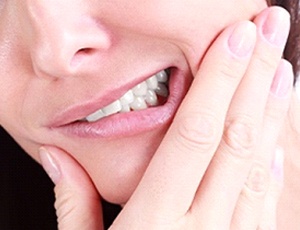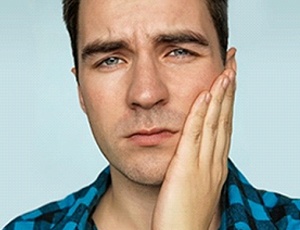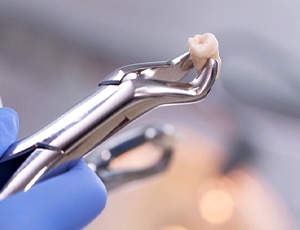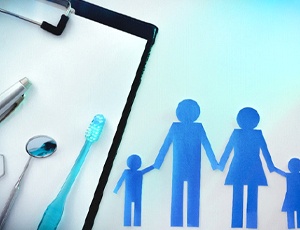Tooth Extractions
Safe, Comfortable, and Performed By an Expert
Removing teeth is never our first choice at Canyon Creek Family Dentistry of Richardson of Richardson. It is always our final recourse when there are no other options, but when removing one tooth will benefit the health of your whole smile, our team can offer safe, comfortable tooth extractions. If you’re in need of tooth removal or any of the wide range of restorative dentistry services we provide for our patients, please don’t hesitate to give our team a call today. We’ll schedule a treatment consultation appointment for you to come and visit us in our state-of-the-art Richardson dentistry practice. We’ll examine your smile and help you to develop a personalized tooth extraction plan, and when necessary, we will also plan to replace your lost dental structures.
When Tooth Extractions are Necessary

We will do our best to help you avoid tooth extractions, but we may need to provide them to protect your overall health in the following situations:
- Severe tooth decay or damage that destroys more than half of the tooth’s structure
- Primary (baby) teeth that do not fall out naturally
- Teeth are impacted (do not erupt)
- To prepare for orthodontic treatment when crowding is an issue
- To prepare for the design and placement of partial or full dentures
- Third molars (wisdom teeth) are the most often removed
Why Wisdom Teeth are Typically Removed

There are many reasons why we may need to remove your wisdom teeth. Their late eruption into the smile often means that patients don’t have adequate space to accommodate an additional set of molars. This can make it impossible for the wisdom teeth to erupt at all, and it can shift surrounding teeth out of alignment. In order to protect overall oral health in these situations, we will recommend wisdom tooth extraction.
While there are some rare occasions where the mouth is large enough to accommodate wisdom teeth, it’s not typical that all four can fit inside the mouth. If this is the case, we’ll often recommend extraction, especially if we believe it will only put you at risk for serious dental problems (including oral infections.)
The Tooth Extraction Process

Tooth extraction is completed either by pulling or surgical removal. Pulling a tooth is possible only if the tooth has fully emerged from the gum line. When this happens, we can numb the area and use a clasp tool to shift the tooth back and forth until it breaks free from the supportive structures. Surgical removal may be simply cutting away soft tissue to reveal additional tooth structure, or it could include more advanced methods like drilling into supportive bone tissues or breaking the tooth into smaller pieces.
In the event you’re feeling nervous or anxious about having a tooth removed, our office is also happy to provide sedation dentistry to help you feel more at ease ahead of and during your procedure.
Aftercare Tips to Keep in Mind

Following the removal of one or more teeth, our knowledgeable team members will walk you through how best to care for your smile as the tooth extraction site heals. Everyone is different, but in most cases, we will recommend the following:
- First 48 hours – only consume liquids. Change out gauze as necessary as it becomes saturated. Use ice packs at 20 minute intervals to reduce swelling and inflammation and slow bleeding. Brush and floss teeth twice a day taking special care to avoid the extraction site. Avoid smoking or using tobacco in any form. Do not drink liquids through a straw as this can potentially dislodge the clot that forms after treatment.
- First week – begin eating a wider variety of foods as you feel capable. You should begin to notice a significant decrease in discomfort and sensitivity. If your pain persists or worsens after the first two days, call our team. If we’ve provided antimicrobial mouth rinse, use this as directed to aid in the healing process.
- Ongoing – if you have stitches that need to be removed, we will typically schedule this appointment for a week or two after extraction. After the first week, you should feel almost back to normal. If you’re still experiencing significant pain, please let us know.
Understanding the Cost of Tooth Extractions

The cost of tooth extraction in Richardson will vary from patient to patient. Although you may not be looking forward to the idea of undergoing this type of procedure, you can rest assured that not only will our team at Canyon Creek Family Dentistry of Richardson ensure the health and future of your smile, but we’ll also alleviate your concerns and stresses regarding the financial aspects of your treatment.
Factors That Can Affect Tooth Extraction Cost

Once you meet with your emergency dentist in Richardson, we will be able to evaluate your smile and determine exactly how much you can expect to pay for your tooth extraction. But until then, we cannot consider all the factors, some of which will include:
- The type of tooth that must be extracted (i.e., incisor, molar, etc.) as well as its location inside the mouth, and how many teeth you’ll need to have removed
- Whether you will require a simple or surgical procedure, as they are very different and require advanced methods and techniques to successfully remove the tooth
- The type of restorative treatment needed to replace the extracted tooth (i.e., dental bridge, dental implant, partial or full denture)
Does Dental Insurance Cover Tooth Extractions?

Most dental insurance companies consider tooth extractions to be major restorative procedures, which is why you will find that a majority agree to cover them at 50%. However, this percentage can vary depending on whether you’ve met your deductible and how much of your yearly maximum is available. You should know, however, that your policy may only agree to pay for a certain number of teeth to be removed, and you may have a waiting period you’ll need to abide by.
If you need help to confirm with your dental insurance company, do not hesitate to ask! We’re here to help make this process easy and simple, so you stress less.
Other Options for Making Tooth Extractions Affordable

We understand the realization of having a tooth extracted can be an unexpected expense for you and your family. This is why we offer other ways you can pay and still keep your treatment affordable. At Canyon Creek Family Dentistry of Richardson, we proudly accept Medicaid and offer flexible financing through CareCredit. By breaking up the cost of your treatment into manageable monthly payments, you can avoid the red tape of insurance and instead, pay back the cost while adhering to your budget.
Our team is ready to help you achieve a healthier smile. If you need a tooth extraction but are unsure how you plan to pay for it, make sure to reach out to our dental team for help. We’re here to provide assistance in navigating your plan and ensuring your out-of-pocket expenses remain low.
Tooth Extraction FAQs

If you’ve never had teeth removed before, we understand that you may have questions about your procedure or why we recommend it in the first place. At Canyon Creek Family Dentistry of Richardson, we’re happy to answer your questions and provide a detailed explanation for why a tooth may need to be extracted. For your convenience, you can read through some of the most common questions we’ve heard from previous patients below!
What should my treatment area look like as it heals?
After about 24 to 48 hours, the treatment area should begin to show a blood clot forming in the socket. This will ensure that bleeding does not occur day-to-day. Your body will also begin to develop tissue to cover the wound. You may notice the area turning a white color, which consists of collagen as well as blood vessels and white blood cells, which is normal.
How long do I have to wait to receive a dental implant?
More often than not, it’s actually better to receive a dental implant immediately after a tooth is extracted in order to minimize bone loss following treatment. However, there are some exceptions. For example, if the tooth needed to be extracted due to gum disease, periodontal therapy will need to be completed before an implant can be confidently placed. After the socket has fully healed, we can then start thinking about tooth replacements like dental implants.
Will a tooth extraction hurt?
Most patients are surprised by how comfortable dental extractions are compared to their expectations, and this is largely because of the local anesthetic that’s applied before treatment begins. You may notice some minor pressure during the removal itself, but the anesthetic ensures no sensation is felt. After it wears off, though, you can expect some mild soreness. This is a normal part of treatment and should go away on its own.
